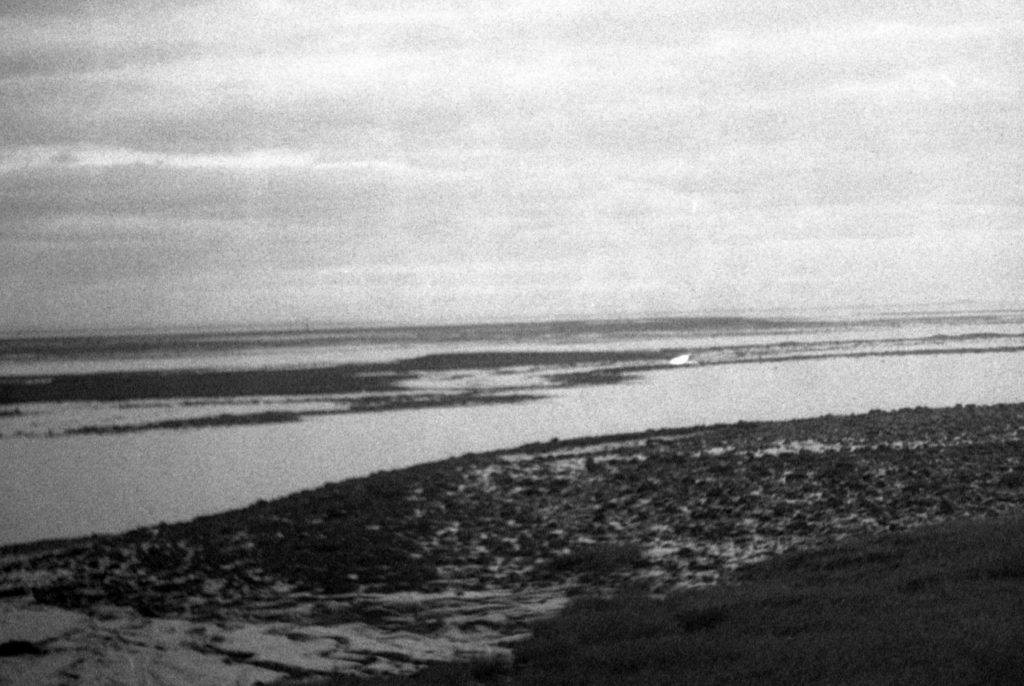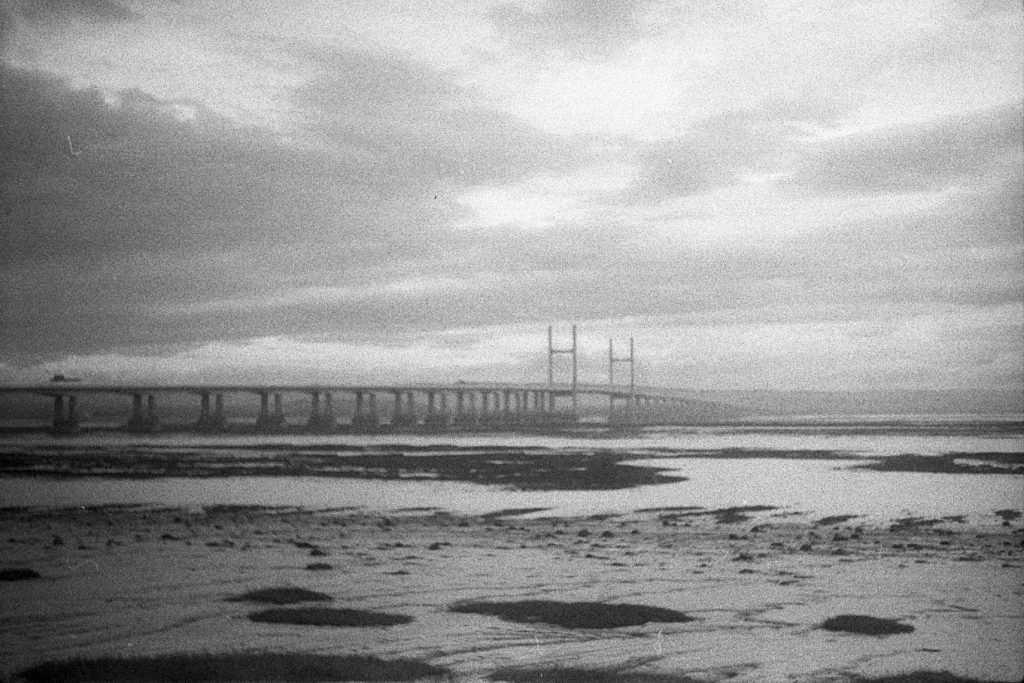By Michael Malay.
A few years ago, during a dry period of life, when I felt severed from the places I knew as home, I began going to a place called Severn Beach. It’s a village ten miles north of Bristol, at the end of the local train line. At first I went every few months, but it wasn’t long before I began visiting every fortnight and then every week.
The place is a little hard to explain. Had you come a hundred years ago, you would have found hotels and tea gardens, fun fairs and donkey rides, as well as an outdoor swimming pool called The Blue Lagoon. Every summer, tourists visited in their thousands, to take in the sea air by the estuary or drink tea shipped in from Ceylon and India. But today an air of neglect hangs over the place. The hotels and tea gardens disappeared in the 1970s, the public pool was demolished in the 80s, and the last pub closed in 2002. Arriving at the train station, you’ll find the flowerbeds left untended and the platform littered with broken glass, beer cans and crisp packets. A clairvoyant practises her trade near the village centre, offering to read your spirit worlds, and just over a mile away, beyond a set of fields, are the distribution centres for Tesco, Next and B&M.
Still, it’s a quietly extraordinary place, and now, whenever I’m away for too long, I find myself growing grim about the mouth, deprived of something good and free.

When you leave the station you’ll find a small ramp at the end of the street. Climb it. This is the sea wall of Severn Beach, and as you mount it you’re often scoured by wind, which sweeps past in short manic bursts or long relentless squalls. You are at one of the edges of England, meeting the winds as they arrive from the Atlantic, and before you is the rocky, muddy, salty, light-filled world of the Severn estuary. Big sky, big water. Miles of mud.
The climb is always worth the view, even in freezing winter winds, for nothing stays the same at Severn Beach. The birds are always coming and going, the mudflats emerging or receding, and the tides retrieving something new, from the Anthropocene detritus of fridges, plastic helmets and galvanised buckets, to the gifts of mermaid’s purses, polished driftwood and ravelled seagrass. It’s a reliably smelly place — the rotting seaweed and sulphurous mud get right up your nose — but it’s also full of glorious sleights of hand. When the sun burnishes the water with the right sheen — the sheen of hammered gold, or of mackerel shoals turning beneath the sun — the estuary can look strangely insubstantial, less estuary than a floating plane of light. Then it seems to levitate above the seafloor, as if, at this time of light-dazzle, water were exempt from the laws governing mass. The effect is particularly strong in the summer, when heat and light thicken the air, but I’ve also seen the same effect on bright winter days. Always, though, the estuary’s pong brings you back to earth, rubbing salt and mud into your visions of another world.
I didn’t like it at first. Many years ago, when I first arrived in Britain, I visited Severn Beach on a whim, curious to see what lay at the end of the local train line. I came on a day of wind and rain and remember feeling disappointed by what I saw: mile upon mile of mudflats, the estuary’s sunken bones exposed by the ebbing of the tide. To the south was the port of Avonmouth, a series of cranes and squat buildings, while to the north were the imposing girders and towers of the Severn Bridge, with its constant heave of traffic. There was no place to swim, no sand to sift through your fingers, and nothing that you could recognise as ‘beach’. Or, rather, nothing I could recognise as beach. As a boy growing up in Indonesia, beaches meant the hot sands of Parangtritis, Kuta or Sambolo, and later, when my family moved to the Queensland, Australia, it meant the beaches of Surfers Paradise, South Stradbroke and Rainbow Bay. And while I had tempered my expectations upon visiting Severn Beach, I still wasn’t prepared for the sight of so much mud. I don’t think I stayed for very long.

But if I didn’t care for this estuary when I first arrived, I now feel drawn to it. I like to see what happens here: the birds banking in the freedom of the air, the tides generating deep water-folds by the pylons of the bridge, and the island of Flat Holm glowing in late afternoon sun, a bar of gold laid across the estuary. Increasingly, I have also been coming for what I cannot see. Every spring, juvenile eels arrive here in their millions from the Atlantic Ocean, and, every autumn, adult eels depart in their thousands, leaving their river dwellings for the Sargasso Sea. And in between these comings and goings are certain yellow eels, who, having migrated here many years ago, and being content to go no further upstream, made this estuary their home. Somehow, despite the churn of forces passing through this place — billions of litres of water, carrying millions of tons of silt — the eels had found a way of staying put. They would be here right now, on the other side of the seawall, muscled cables lengthening in the dark.
‘There are tides in the body’, Virginia Woolf wrote, secret urgings and hidden gravitational forces. Not all of them make sense. Walking along Severn Beach, I sometimes wonder at the pull this place has on me, and how different things were when I first stood here. That younger self was homesick for the places he had left behind, for known customs and manners, but he was also excited by this place called England, by the world at his nose. Still, he thought of himself as a visitor, living here on borrowed time. So how odd to be drawn here week after week, walking along the seawall as oystercatchers wheel above the estuary; and how strange to be combing the shingle beach for bits of driftwood, or skipping rocks across the water, not as a boy in Indonesia, or a teenager in Australia, but as a grown man on the shores of the Severn. I have come to know this place over the years, perhaps even to love it, although ‘love’ may not be the right word, for the estuary is neither a sentimental nor a forgiving place. ‘You have to understand it inside out’, my friend Jessie told me once, ‘or you’ll be in trouble’. Having spent years sailing around the coasts of Britain and Ireland, she tells me that the estuary, with its formidable currents and tides, its concealed sandbars and rocky islands, is one of the most dangerous places she’s experienced. But that’s also part of the attraction. Though we come to its edges, to wonder at the bright flowing unstillness of it all, the estuary is its own place, with its own wild mind, and has no regard for what we think.


What a nicely written piece, thank you. I relate quite closely to the experience of growing to love the new places you end up in as an immigrant and missing them when you are away from your new home. It is all very contingent, a mutual process of becoming where “oneself” (no such thing as one-self right?) , the places and the sense of time mutually transform each other.